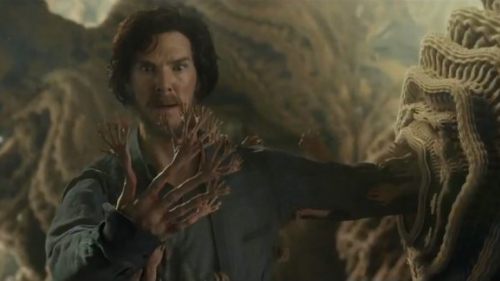The Savage Stack - SINISTER (2012)
There’s always going to be – for lack of a better term – a stack of films we’ve been meaning to get to. Whether it’s a pile of DVDs and Blu-rays haphazardly amassed atop our television stands, or a seemingly endless digital queue on our respective streaming accounts, there’s simply more movies than time to watch them. This column is here to make that problem worse. Ostensibly an extension of Everybody’s Into Weirdness (may that series rest in peace), The Savage Stack is a compilation of the odd and magnificent motion pictures you probably should be watching instead of popping in The Avengers for the 2,000th time. Not that there’s anything wrong with filmic “comfort food” (God knows we all have titles we frequently return to when we crave that warm and fuzzy feeling), but if you love movies, you should never stop searching for the next title that’s going to make your “To Watch” list that much more insurmountable. Some will be favorites, others oddities, with esoteric eccentricities thrown in for good measure. All in all, a mountain of movies to conquer.
The eighty-fourth entry into this unbroken backlog is the super creepy new classic Sinister...

When discussing the history of "found footage horror" – a term that's somewhat problematic in a very basic sense, but we'll get to that in a bit – the most common conversation starter is The Blair Witch Project ('99). Notable for its guerilla marketing campaign (that even utilized primitive website design), Daniel Myrick and Eduardo Sánchez’s superbly scary picture is often credited as being a progenitor of sorts. In her book Found Footage Horror Films: Fear and the Appearance of Reality, Alexandra Heller-Nicholas states:
"The contemporary found footage horror subgenre famously began with the phenomenal success of The Blair Witch Project. However, the ascendancy of so-called "torture porn" – typified by Saw (James Wan, 2004) and Hostel (Eli Roth, 2005) – saw found footage horror recede from mainstream attention. The founding of YouTube in 2005 and its spectacular growth during 2006 sparked a growing taste for amateur media, which in turn saw a spike in the production of found footage horror in 2007 with the appearance of [Rec] (Jaume Balaguero and Paco Plaza) and Diary of the Dead (George A. Romero) and Cloverfield in 2008. Along with YouTube itself, these movies paved the way for the phenomenally successful nature of Paranormal Activity (Oren Peli, 2007)."
Indeed, Paranormal Activity was a smash, to the tune of $194 million worldwide on a nothing budget of $15,000. Up until that point, Jason Blum and Blumhouse Productions were another mere Hollywood upstart, having produced four films prior that barely penetrated the general public's consciousness. Not only did Oren Peli's original picture launch Blum's first franchise, it also enabled the producer to take further gambles in the genre, investing in projects by Wan and his Saw cohort Leigh Whannell (Insidious ['11]) while the three PA sequels released between 2010 – 2015 grossed almost $700 mil globally. Suddenly, Blumhouse was a genre powerhouse, here to stay and enable future horror luminaries.
On the surface, Sinister ('12) operates as a wrinkle on the "found footage" formula, asking the question that's always rendered many of the subgenre’s entries problematic (at least in this writer’s eyes): "who the hell shot/found this footage?" Naturally, director Scott Derrickson and co-writer C. Robert Cargill (who would re-team after this movie's sizable success for Marvel's Doctor Strange ['16]) aren't the first folks to provide an answer to this plot-hindering riddle, as Ruggero Deodato's Cannibal Holocaust ('80) is infamously bisected between a straight-forward narrative chronicle of a professor's descent into the Green Inferno before returning with canisters of atrocity-riddled celluloid. Instead, Derrickson and Cargill have updated the formula and even combined it with modern haunted house textures, crafting what still stands as perhaps the quintessential Blumhouse horror release.
Sinister's rudimentary plot revolves around an ingeniously simple logline: disgraced true crime author Ellison Oswalt (Ethan Hawke, donning the comfiest of sweaters) moves his beautiful wife Tracy (Juliet Rylance) and adorable children Trevor (Michael Hall D'Addario) and Ashley (Clare Foley) into a new home where (unbeknownst to his brood) the previous clan was mysteriously hung from a tree in the backyard. Financially strapped and needing a new hit novel, Ellison settles in and begins digging into a box of films he finds in the attic, each containing a different slaughter more awful than the last. Suddenly, he's got his topic, but who the hell is making these demented home movies, and how come they stretch back to the '60s? Is it the work of a serial murderer…or something else?
These brutal 8mm slayings play like a cross between slasher set pieces and clips from some lost American appropriation of the horrid Japanese Guinea Pig series (which began with Devil's Experiment ['85] and ran to Mermaid In a Manhole ['88]). The unifying theme is family annihilation, as a separate, seemingly normal, happy unit is butchered, burned, drowned or (in the movie's most shocking moment) run over with a lawnmower. Though these instances of graphic violence are undeniably unpleasant, there's also a sense of glee that lends them an invigorating energy, as Derrickson is clearly having a ball trying to make you run screaming for the exits (or, at the very least, flip the light switch in your living room). It's a nuanced balance between cruelty and escapism that powers the very best horror pictures to greatness.
Ethan Hawke doesn't initially strike one as a genre god, what with his numerous Richard Linklater art house collaborations, directorial efforts chronicling musicians such as Blaze Foley, and recent team up with Paul Schrader (for that master's transcendent slow show First Reformed ['18]). However, Hawke has also amassed quite the horror/sci-fi/action oeuvre over the years, playing everything from tortured rookie cops (Training Day ['01]), to chic vampires (Daybreakers ['09]), to legalized crime victims (The Purge ['13]) over the years. For Ellison Oswalt, the seemingly ageless actor brings just the right amount of grey to the character's morality, making us root for and side-eye him simultaneously. The author’s both a rabble-rousing huckster for whatever town he shows up in, as well as a pretty shitty husband and father once his research and "creative process" take over, creating quite the complex, adult protagonist.
Speaking of creation, as much as Sinister is constantly attempting to spook you, there's also a fair amount of scrutiny applied to the "writer" archetype, and how committing a little too much to your art can essentially damage the human connections you've built. As Ellison slips deeper into obsession with these crudely developed films, he begins drinking more and more to cope with what he's witnessing. His wife knows that something's wrong (and cryptically hints that she'll take the kids if Ellison gets as bad as he did on "the last one") and eventually begs the man she loves to give up the dream, for it could cost him everything. Yet he clings to this notion that the only legacy he'll leave behind after he's shuffled off this mortal coil is the writing he completes, and without that he's nothing. For anyone who's ever struggled to put something out into the world (and whose partners have stood beside them during their most foolishly stubborn moments), the tension Hawke and Rylance generate during these arguments will hit real close to home.
Perhaps Sinister’s most impressive element is how smoothly it transitions into the supernatural portion of its narrative, as Ellison begins hearing the pitter-patter of little feet on the ceiling above him, and ghosts start to emerge out of the darkest shadows. It's a wonderful bit of horror cinema execution, as Christopher Norr's cinematography becomes impossibly moody, bathing every corner of this presumably comfortable Pennsylvania home in blackness fit for Castle Dracula (a backyard scene filled with fog is straight out of a Eurohorror nightmare). Meanwhile, Hellraiser ('87) composer Christopher Young keeps you constantly on edge with his throbbing orchestration, which inserts selections from Accurst's "Fragments" to heighten acutely timed scares.
Thankfully, Derrickson and Cargill recognize that there has to be some levity to provide breaks from the constant doom and gloom. This humor (not to mention humanity) comes in the form of Fred Thompson's grumpy small town Sherriff and James Ransone's scene-stealing Deputy "So-And-So". Ransone in particular proves again why he might be one of the most underrated actors working today, taking what could've just been a bumbling side-player and gifting him real purpose, as the cop (whose name Ellison arrogantly doesn't even bother to learn) proves to be much more competent than we initially suspect. Rounding out the small but mighty cast is the legendary Vincent D'Onofrio (beamed in from his home planet via Skype), who acts as an occult advisor to Oswalt, filling him in on the child consuming Pagan deity Bughuul that the writer may have inadvertently raised with his research.
Sinister went on to become another splash for Blumhouse, earning a sizable $84 million worldwide and spawning a sequel. Nevertheless, even if the movie had failed, Derrickson and Cargill's unsettling creation would still sit near the summit of contemporary American horror. It's a movie that's wonderfully shaded, tonally assured, and contains an ending that keeps you up well past bedtime, hoping beyond hope that there's no truth to this true crime author's discoveries. By toying with convention and expectation, the creative duo minted a new classic, destined to continue scaring the ever-loving shit out of anyone who dares stumble upon their warped re-tooling of the found footage aesthetic.
Sinister is now available on Blu-ray and DVD from Summit/Lionsgate Home Entertainment.



